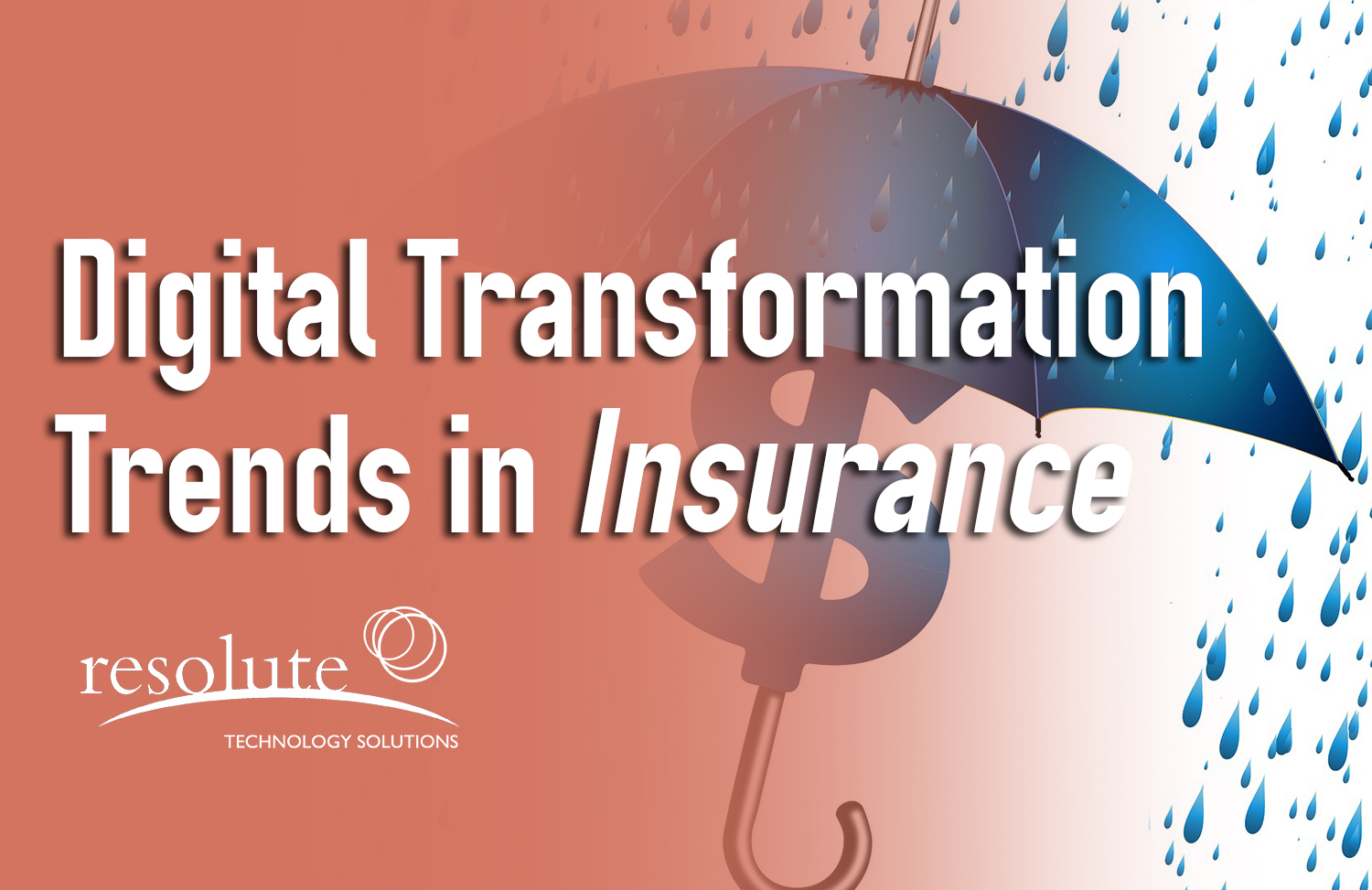The insurance industry has long been held back by manual processes, difficult-to-digitize workflows, and restrictive custom software for submitting, tracking, and paying out claims. Large insurance companies entrenched in legacy technology have historically found it hard to take advantage of advancements in technology without major changes to their business processes and underlying systems.
Now, as customers demand a better experience, more communication, and cheaper rates – insurance companies are being forced to find ways to adapt and leverage modern technology or be left behind.
Insurance companies that are able to leverage digital technology to improve their business see benefits of digital transformation such as automating manual processes, enhanced insights via data analysis, increased customer retention rates, efficiencies throughout workflows, cost savings, better risk management, and more.
In a recent study by Celent on what was driving digital initiatives in insurance, improved customer and channel experience came out on top. Following not far behind was ‘implement advanced data and analytics’ and ‘achieve process excellence’.
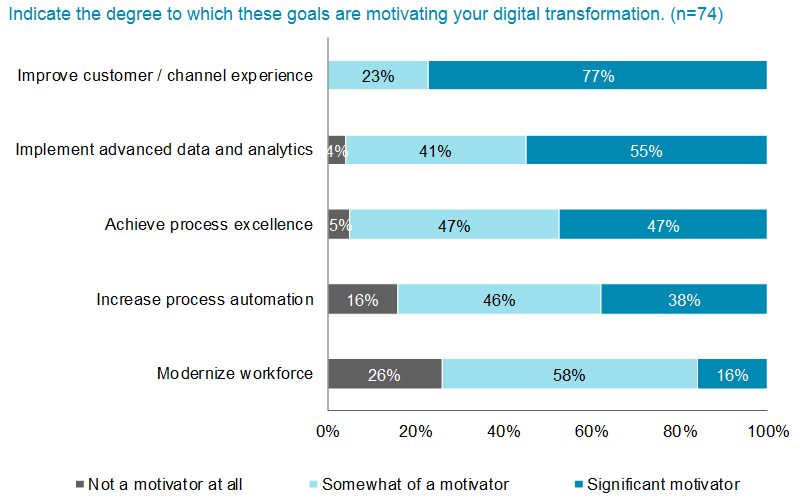
Image source: https://www.celent.com/insights/127860288
Digital Transformation in the Insurance Industry
Digital Transformation in insurance is wide-ranging. It can mean adding digital tools to improve existing processes or completely re-imagining how a company delivers value to customers, staff, and stakeholders. It’s important businesses outline what they want to achieve to make the most of their transformation.
There are many avenues for insurance companies to employ digital transformation. Some are building in-house capabilities by upgrading or replacing their internal core business applications and platforms. This can be very expensive and time-consuming but is ultimately one of the only ways to modernize your business technology without relying on third parties indefinitely.
A replatforming or platform modernization project requires many advanced skills and expertise including roles like business and system analysts, architects, project managers, developers, subject matter experts, and specialists familiar with the platform or underlying software language.
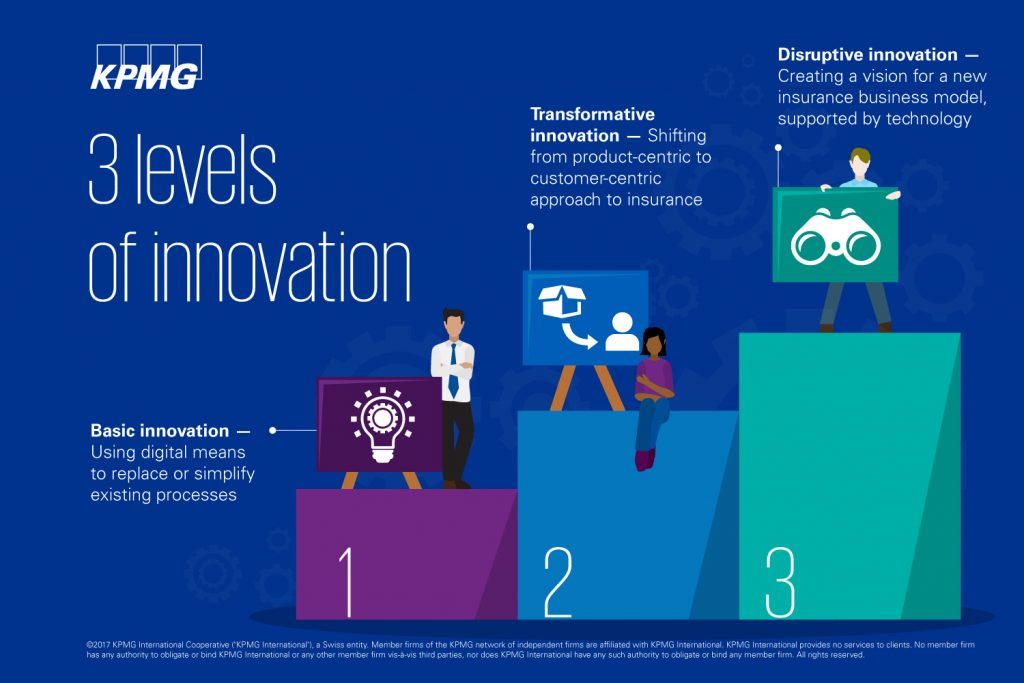
Partnering with InsurTech Companies
Many insurance companies choose to partner with new disruptors to the market: Insurtech. Insurtech companies offer software solutions that plug into existing infrastructure and applications with integrations. Think of Insurtech as insurance technology that either replaces a current manual function or vastly improves the way of doing it to derive more value from the interaction.
Insurtech firms are digitally transforming the way insurers handle key aspects of their business and often partner with more established insurance providers to pair their new technology functionality with larger customer bases.
Insurance companies are leveraging new technology to update their backend claim systems, benefits platforms, customer portals, and more.
Here is a sample of the new firms entering the insurtech space and how it impacts digital strategy for insurance companies:
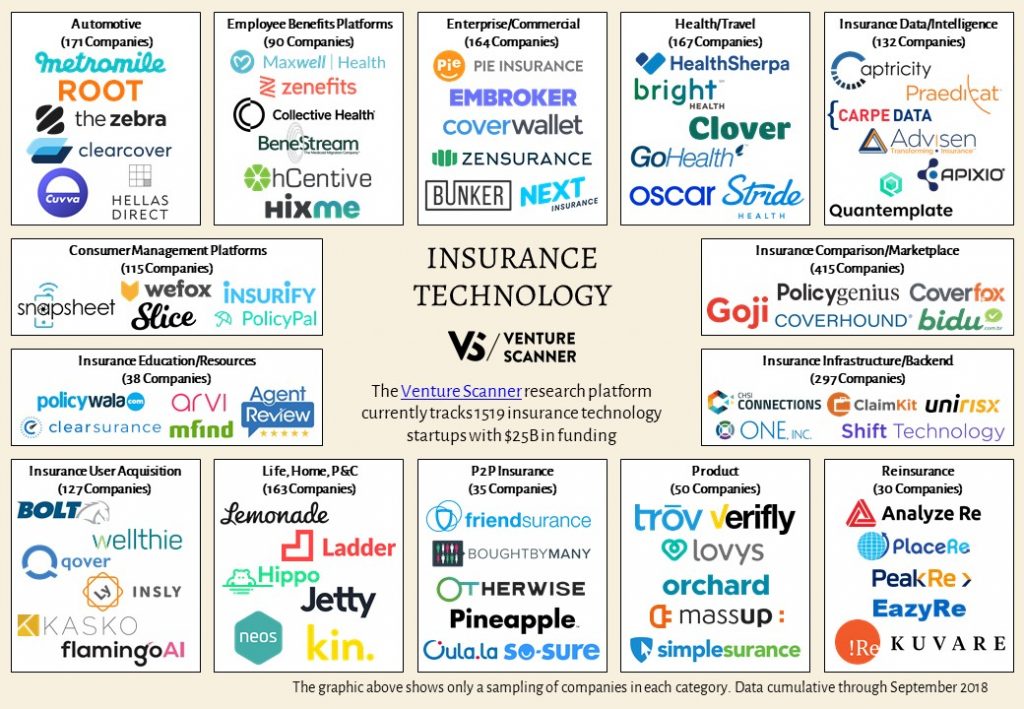
Image source: https://venturescannerinsights.files.wordpress.com/2018/12/insurance-technology-sector-map.jpg
Self-Service Portals
We’ve covered What is a Self-Service Portal on our blog before and listed out How a Self-Service Portal Enhances Customer Experience and How Self-Service Portal Can Save Insurance Companies Money. Here is the quick overview on how self-service continues to be a prevalent trend in digital transformation for the insurance industry.
Self-service portals often act as a stepping stone to digital transformation in insurance by allowing customers to submit claims, request support, receive payment, and other functions in a self-directed, digital format.
Self-Service portals offer many benefits, which include:
- Better customer experiences
- Automating manual tasks to save money and time
- A centralized way of collecting data
- Allowing customers to launch claims wherever, whenever via mobile
- Reducing claim processing time
- Enabling real-time notification when claims are updated
Omni-Channel Support and Communication
Many organizations add self-service portal as part of their omnichannel support strategy. It allows customers to submit claims and search for answers themselves which still maintaining traditional methods of support to alleviate some stress of the support team and still appealing to some customer’s preference of communicating with a live agent.
However, some insurance companies are extending their support and communication options with their customers to website live chat (both human and chatbot), social media, via mobile app, and more. Omnichannel support can be a key part of an insurance companies’ digital transformation strategy.
If an organization wants to make communication with their clients a priority, they can restructure their communication options to include all the primary ways their customers would like to reach out and tie them together to a singular customer profile from the back-end. That way the customer is always receiving a seamless experience whether they reach out by phone, online, walk into a branch or launch a claim themselves.
From EY’s Global Consumer Insurance Survey, Omnichannel distribution is crucial to improving both the quality and frequency of customer interactions.
- 75% – Customers very satisfied with current outbound communications from insurers
- 44% – Customers who have had no interactions with their insurers during the prior 18 months (see details below)
- 38% – Customers who claim to be advocates but cancel policies or switch providers
- 80% – Customers willing to use digital and remote channel options for different tasks and transactions
Automation Leading to Easier and Faster Claims Processing
One of the primary digital initiatives in insurance is identifying manual processes and bottlenecks in workflows and using digital technology to automate them. By adding integrations between systems, insurance companies can ensure data flows through from one system to the next without manual intervention.
Companies can achieve this by bridging their older, legacy systems with custom integrations to streamline high volume, repeatable tasks or moving to a new platform that has this functionality.
Some of the functions and processes that can be automated include:
Claims Submission and Processing – By automating the claims intake process with self-service, insurance companies are saving considerable time and improving the accuracy of data collected. By leveraging prequalification checks and scoring, businesses can route new claims and business requests based on the level of detail needed to process it. For simpler claims, insurance companies may be able to enact straight through processing provided the claim meets the appropriate criteria.
Policy Administration and Customer Service – In terms of policy administration, insurance companies can enable automated renewals and cancellations to save time and focus it on other high value areas. Similarly, for customer service, chatbots can help respond to simple customer inquiries or collect enough information to reduce the time to resolution considerably. By automating support intake, it allows the support agents to focus on the actual problem.
Underwriting – A big part of digital transformation in the insurance industry can be attributed to the advancement of intelligent tools. There are systems to help underwriters automate risk data collection, predict risk quality and pricing, and can suggest an automated or hybrid approach based on whether a renewal or new submission meets certain criteria.
Media Reading – Smart media readers have come a long way in being able to scan paper documents and transfer their contents to a digital format. There is a lot of paperwork generated during policies and claims processing with pertinent information that may need to be accessed again later. This can be time-consuming when done manually but smart media readers have capabilities to extract relevant data and connect it to the other insurance systems.
Compliance – While most aspects of regulatory compliance are too complex to automate, there are still some areas where it can be beneficial including automated data collection and preparation, regulatory report scheduling, and automated compliance communications. Depending on a company’s specific needs, streamlining compliance can be one of the higher-value digital initiatives in insurance.
McKinsey states in their Automating the Insurance Industry report that 25% of full-time positions in insurance will be consolidated or reduced largely due to automation with the largest impact to Operations and Administrative support. As intelligent automation continues to get more advanced it may affect the other areas more profoundly.
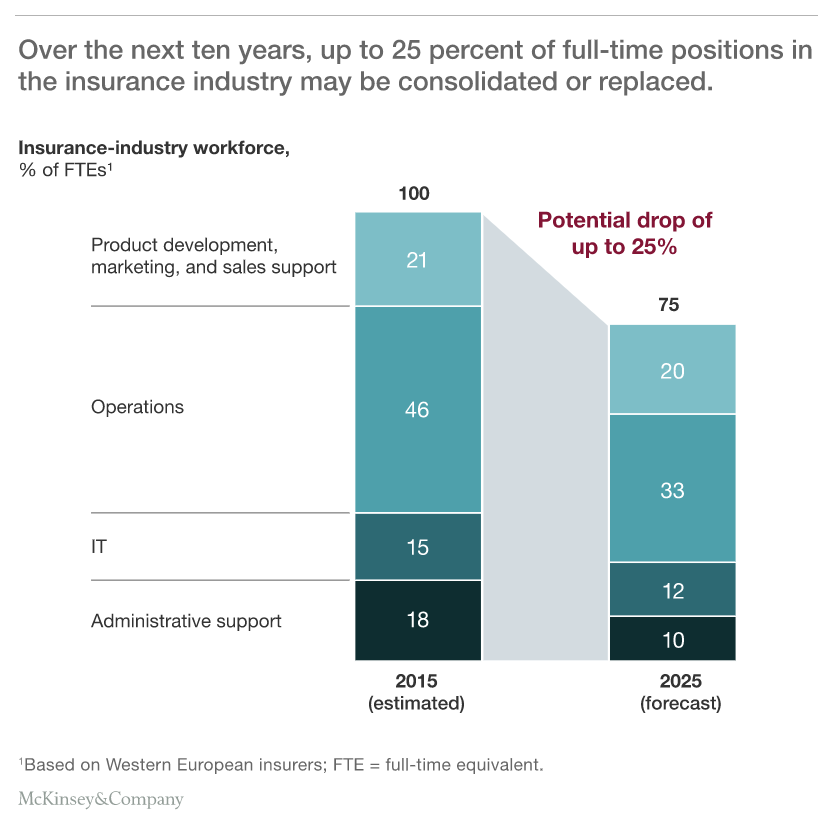
Image source: https://www.mckinsey.com/industries/financial-services/our-insights/automating-the-insurance-industry
Advanced Analytics and Big Data
The insurance industry is finding innovative ways to leverage mass amounts of data for better risk predictions, pricing strategies, and enhanced customer insights. With the development of IoT sensors, social media prevalence, mobile technology, and more advanced computing systems in vehicles – there are data points everywhere that can be analyzed for enhanced service offerings.
With the capability to add sensor technology to the main areas of insurance: homes and buildings, vehicles, and even people via wearable and mobile technology companies are able to better evaluate the risks they are underwriting and what prices to associate with them.
Insurance companies at the forefront of technology can incorporate AI and Machine Learning into their insurance systems to identify key indicators that people may miss or take considerably longer to discover. AI programs can be set up to scan for fraudulent claims, provide risk levels, and streamline tasks that would otherwise require human intervention.
Nearly all of the trends related to digital transformation in the insurance industry are underpinned but the effective collection and used of data and analytics.
Finding Practical Insurance Applications for Blockchain
Blockchain is still a relatively new technology and insurance companies are still testing out the waters with how they can leverage it. The value in using blockchain technology is it allows for transferring information and making transactions between two parties securely.
Blockchain has the opportunity to disrupt Insurance processes in many ways. Deloitte, drew up this infographic in their report, Blockchain in Insurance: Why should you care?
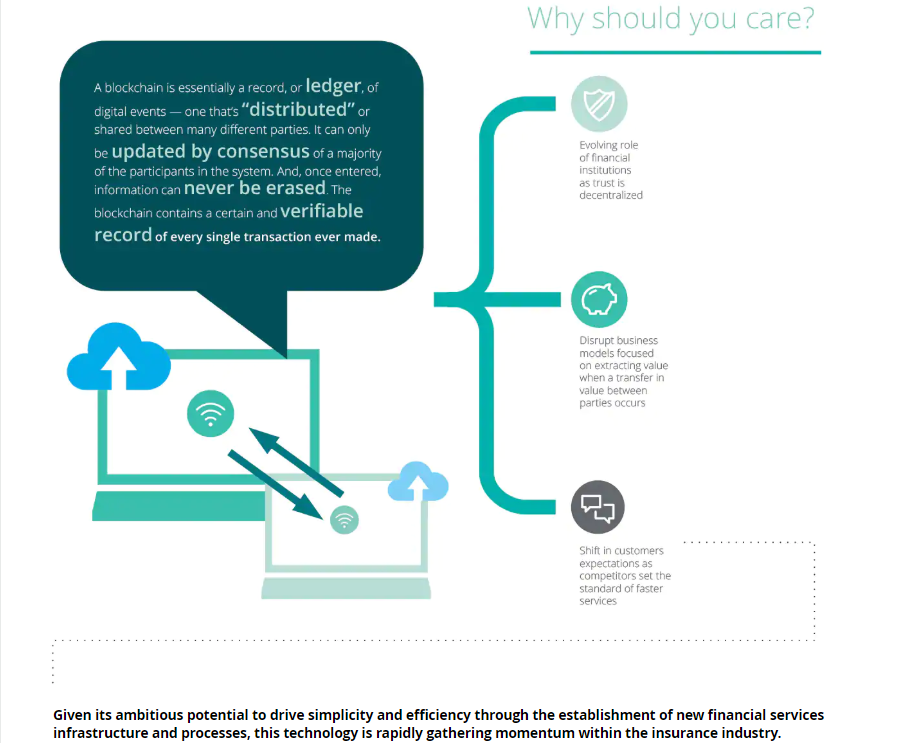
For most companies that don’t have large R&D or digital innovation budgets, watch for InsurTech companies to bring blockchain products to market in the coming years. Partnering with a company that builds blockchain solutions for insurance decreases the barrier to entry by allowing firms to leverage the technology without building an in-house capability to manage it.
Digital Transformation for Insurance
As the insurance technology landscape continues to evolve, companies will continue to find ways (through a partnership with InsurTechs or building in-house capabilities) to leverage new digital tools to streamline business processes and enhance the customer experience.
Digital transformation in the insurance industry is still young compared to the modernization of other industries but that means there are that many more opportunities to explore. As companies get to the next stage of their digital transformation, they unlock more opportunities to continue expanding capabilities.
By digitizing manual, outdated processes, organizations can store and leverage pertinent data. With this data, they can move into advanced analytics using AI, machine learning, and automation for enhanced insights and actionable improvements. This cascades into improved experiences, lower costs, better communication, and an overall improved insurance workflow and products.
–
If you work in the industry and want to determine what aspect of digital transformation in insurance will benefit your business most – book a free consult with us. Our experts will help analyse business needs and requirements, identify improvement areas and assist you in selecting and implementing the right tools to revamp processes to make the most of digital technology.



